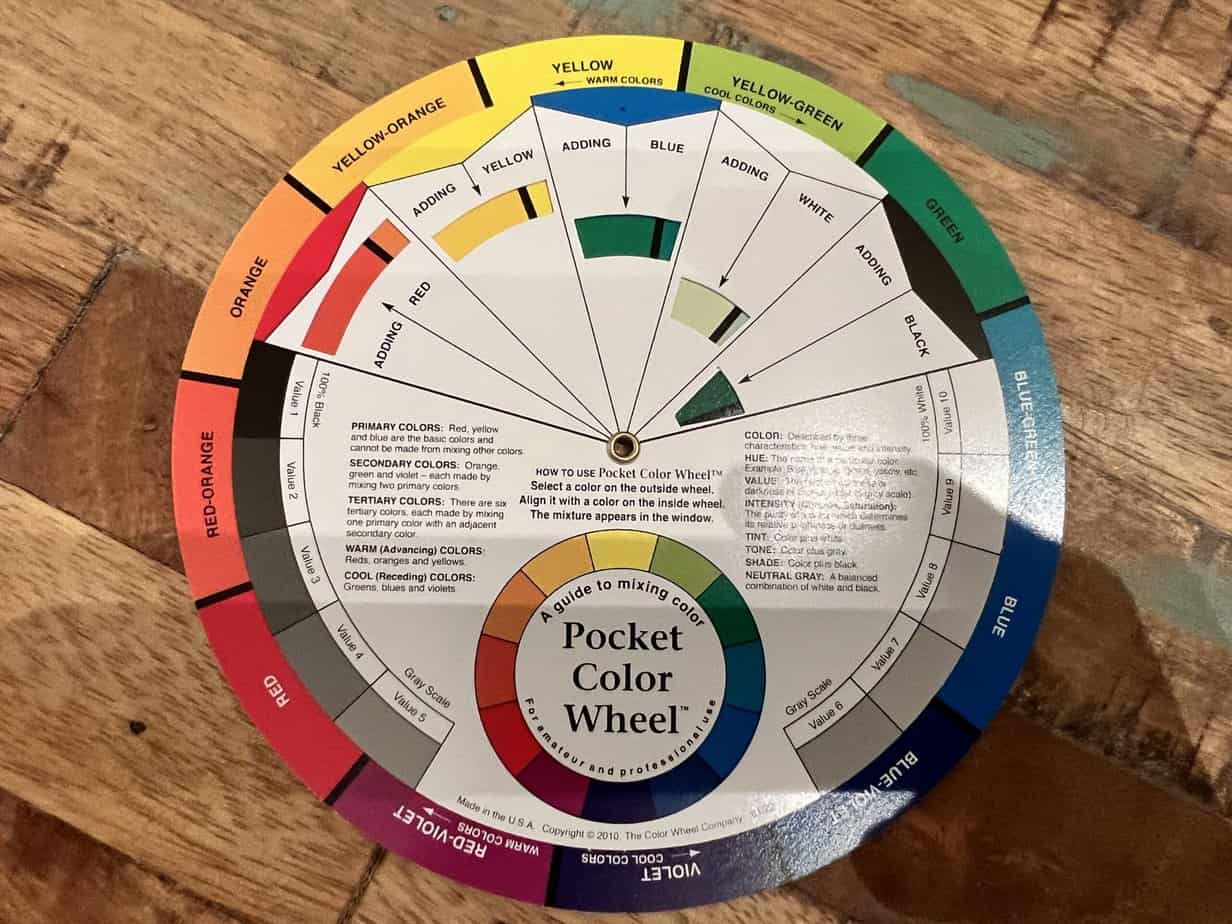
In the world of hair color, bold and vibrant shades get a whole lot of attention. That's why many of us gravitate to these ambitious hues. Reds, blues, oranges, purples, and more are all fair game.
But what happens when your hair color adventures leave you with an unwanted purple tint? One of the most straightforward solutions is to cancel out the purple tones, and if you're thinking about going this route, you're in the right place.
What color cancels out purple? Does yellow cancel out purple? In this article, we'll tell you what color cancels out purple, educate you on how the color wheel works, and much more. Let's get right into it.
Table of Contents
What Color Cancels Out Purple?
The color yellow cancels out purple. Although, before you can even think about canceling out the purple in your hair, it's crucial to understand how color theory works. The source of truth when it comes to mixing and canceling out colors is the color wheel. It's a diagram of all the primary, secondary, and tertiary colors in existence.
When you look at the color wheel, there's one thing that you need to be aware of.
Colors that sit opposite each other on the wheel cancel each other out. These colors are complementary to each other. Take a good look at this color wheel - you'll see that yellow is the opposite of purple, and that means that yellow cancels out purple.

Determine the Lightness of Your Purple Hair
It seems simple enough that yellow is the color you need to get rid of the purple tones in your hair. But it's a little more complicated than that. Consider the undertone of the purple in your hair. If it has a blueish undertone, you should use orange. Orange, after all, is opposite the color blue on the color wheel.

How to Cancel Out Purple with Yellow Pigments
You now understand that yellow is the magic color when you want to get rid of purple pigments in your hair. But what are you supposed to do with that information?
There are several ways to cancel out purple with yellow pigments, and we'll tell you how to do it in this section.
Tone Your Hair
Toner is specifically formulated to remove unwanted tones in the hair. Most of the time, people use violet or blue-based toners to get rid of yellow or orange tones in their hair, but in this case, your goal is different.
You need a yellow toner to remove purple unless the purple is more on the blue side, in which case you'll use orange. Here's how to tone your hair:
- Gather Your Supplies: You'll need a hair toner in either yellow or orange. Toners are available in various forms, such as permanent, demi-permanent, or semi-permanent. Choose a product that suits your needs and hair type. Permanent toners will have much longer-lasting results than semi-permanent or demi-permanent. In addition to the toner, you'll need:
- Mixing bowl to mix the components of the dye together (stay away from non-metal bowls).
- Tinting brush - It will give you max control when applying the dye to your hair.
- Developer (for permanent toners only) - Level 10 for short-lived results and level 20 for long-lasting results and more toning power.
- Wide-tooth comb - To aid in distribution.
- Clips - For dividing your hair into sections.
- Your phone or a timer
- Prepare your Space and Protect Skin and Clothing: Wear old clothes, drape a towel over your shoulders, or use a hairdressing cape to protect your clothing. Then, put on gloves to protect your hands. Also, make sure that your work area has adequate ventilation. You can also put some towels or newspapers down to minimize staining from any spills.
- Shampoo and Condition: When toning, you'll start with clean, damp hair. Wash your hair with a clarifying shampoo to remove any product buildup or excess oils. Rinse thoroughly and skip the conditioner. Towel-dry gently with a microfiber towel without rubbing.
- Mix the Toner: Put on gloves and follow the instructions provided with the toner to prepare the mixture. Permanent toners should be mixed with a developer or activator. Use a non-metallic bowl and mix the two components according to the recommended ratios. Stir well until the mixture is smooth and consistent.
- Section and Clip Your Hair: Divide your hair into manageable sections using clips - two to four sections are about right. This will make the application process easier and ensure even coverage. Start by creating a middle part and then section off each side.
- Apply the Toner: Begin applying the toner to one section at a time, starting from the roots and working your way down to the ends. Apply the toner to the purplest parts of your hair first, and then apply it to the rest. Use a tinting brush or your gloved hands to distribute the toner evenly. Comb through the hair with a wide-tooth comb to ensure full saturation.
- Wait for the Toner to Process: Set a timer based on the recommended processing time provided with the toner. This can vary depending on the brand and your desired results. Avoid overprocessing, as it can lead to an undesired color outcome. Keep an eye on the development of the toner throughout the process. To do this, wipe a bit of the toner off of a small section of hair and look at it to see your progress. If there's still some purple pigment on your hair, reapply the toner and allow more time for it to process.
- Rinse and Condition: Once the processing time is complete, rinse your hair thoroughly with lukewarm water until the water runs clear. Follow up with a color-safe conditioner to restore moisture and seal the cuticle. Leave the conditioner on for the recommended time, and then rinse again.
- Style and Maintain: Gently towel dry your hair and proceed with your usual styling routine. Avoid using excessive heat styling tools immediately after toning to minimize damage. Use color-safe and sulfate-free hair care products to maintain your toned color for as long as possible.

What You Need to Know Before Using Toner
Toners that require developers can be damaging to the hair if not used properly. Developers, also known as oxidizing agents, contain hydrogen peroxide. It helps to open up your hair cuticles, allowing the toner into your hair shaft.
While developers are necessary for achieving your desired result, they can have adverse effects on the hair if misused or overused. The higher the developer volume, the more aggressive it can be on the hair, causing hair problems like dryness, brittleness, and breakage.
To prevent hair damage while toning, it's important to follow the below precautions:
- Choose the appropriate developer volume recommended for the toner and your hair condition - never go higher. Lower developer volumes are generally less damaging.
- Never leave the toner or developer on your hair for longer than the recommended processing time, as this can intensify the damage.
- Baby your hair after toning, using hair moisturizing and repairing treatments, limiting excessive heat styling, and keeping up with your trims.

Apply a Semi-Permanent Dye on Top of Your Purple Hair
If you're not well-versed in toning and don't mind the temporary nature of semi-permanent dye, perhaps this is the right method for you. The great thing about semi-permanent dye is that it is super easy to use and won't damage your hair.
Here's a detailed step-by-step guide on how to apply yellow semi-permanent dye to cancel out purple hair:
- Gather Your Supplies: To remove purple tones from your hair, you'll need yellow semi-permanent hair dye for purple hair and orange semi-permanent dye for blue-based purple hair. The brand of the dye doesn't really matter - it's the pigment in the dye that's important. Go for a shade that is a true, vibrant yellow. In addition to the dye, get your hands on the following items:
- Gloves - To protect your hands from staining, wear gloves throughout the process.
- Hair clips - To divide your hair into sections for easier application.
- Tinting brush - Use a brush designed for hair dye application to ensure even coverage.
- Mixing bowl
- Prevent Messes: Put newspaper and towels on your counters and floors to prevent them from staining. Wear clothing you don't mind ruining, and wrap a towel over your shoulders to protect your skin from the dye.
- Prepare Your Hair: Before using a semi-permanent dye, you'll want to cleanse your hair to remove any dirt, debris, or excess oils. Do so with a clarifying shampoo for max cleansing power. Then towel-dry your hair to stop it from dripping.
- Section Your Hair: Divide your hair into 2 to 4 sections using hair clips or scrunchies. Doing so will make it much easier to work with your hair and get even coverage with the dye. Start by creating a middle part and then section off each side.
- Apply the Dye: There's no mixing required with semi-permanent dye. You'll use it straight from the tube or squeeze it into your mixing bowl and use it from there. Put on your gloves, open the dye, and dispense it into the mixing bowl. Mix the dye around a bit to remove any clumps. Then, starting with one section of hair, pick up a small amount of the dye with the tinting brush and apply it generously to the section from roots to ends. Ensure that all strands are evenly coated with the dye. If you have any areas where the purple color is more vibrant, start applying the dye there first. Repeat this process for each section of hair until all of your hair is covered.
- Comb and Distribute: After applying the dye to all of the sections, comb through your hair gently with a wide-tooth comb. This will help distribute the dye evenly and ensure that all strands are covered. It shouldn't be hard to comb the dye through your hair since the product is slippery.
- Wait for the Dye to Process: Read the instructions provided with the dye to determine the recommended processing time. Set a timer and allow the dye to process for the specified duration.
- Rinse and Condition: Once the processing time is complete, rinse your hair with lukewarm water until the water runs clear. Avoid using hot water, as it can strip the color. Follow up with a color-safe conditioner to restore moisture and seal your hair cuticles. Leave the conditioner on for a few minutes, and rinse once more.
- Style and Maintain: Towel-dry your hair and proceed with your usual styling routine.
Remember, it's essential to follow the dye instructions to a T to get the best results.

Use a Yellow Color-Depositing Conditioner
Color-depositing conditioners can be used to reduce your purple hair color for a more wearable shade. It's also incredibly easy to use - you'll use it just like you would a deep conditioner. If your hair is dirty or caked in buildup, you'll first wash your hair with a clarifying shampoo.
Afterward, while you're still in the shower or near a water source, apply the color-depositing conditioner on all of your hair. If you have a lot of hair, you can apply it in sections to ensure even coverage.
Comb the conditioner through and then leave it in for the recommended time - check the packaging for time recommendations. Then, rinse your hair well and style it as desired. To maintain the color, you'll have to use the conditioner regularly.

Other Ways to Get Rid of Purple Hair
It's important to know that coloring over your purple hair might not give you the exact results you envisioned. There are so many factors in play that affect your results.
For many who want to get rid of their current hair color, the best course of action is to remove the existing hair color and replace it with another.
Here are a few ways to do that:
Bleaching
If your purple hair is vibrant and intense, bleaching may be necessary to remove the color. Then, you can apply a new shade. Bleaching removes the existing color pigments from your hair, giving you a blank canvas for a new color application.
It's important to note that bleaching is known to be a very harsh process and can cause extensive hair damage during or after the treatment, so we recommend consulting a professional hairstylist for guidance if you're not well-versed in bleaching your own hair.
Color Stripping
Color stripping is a technique used to remove artificial color from the hair. It involves using a color-removing product that breaks down the dye molecules, allowing them to be washed out.
Color stripping is most effective on semi-permanent or demi-permanent dyes, and the process may need to be repeated several times to achieve the desired result.
Some say that color stripping is gentle, but the more treatments you do, the higher your risk of drying your hair out and making it brittle
Hot Oil Treatments
Hot oil treatments can help fade dye pigments, including purple ones. Warm-up and apply an oil of your choice (like coconut oil or olive oil) to your hair and scalp, ensuring every strand is covered.
Cover your hair with a plastic processing cap and leave the oil on for at least an hour. Wash the oil out with a shampoo of your choice. While this method may not completely remove the purple color, it can help lighten it over time.
Clarifying Shampoos
Clarifying shampoos are designed to remove product buildup and excess oils from the hair. They can also help fade semi-permanent hair color. Use a clarifying shampoo in place of your regular shampoo and massage it into your hair, focusing on the areas with purple color. Leave it on for a few minutes before rinsing thoroughly. Repeat as needed to gradually fade the color.
Vitamin C Treatment
Many have tried vitamin C treatments, and some have had amazing color-fading results after just one use. To give it a try, crush several vitamin C tablets into a fine powder and mix them with a clarifying shampoo to create a paste.
Apply the paste to your hair, focusing intently on the areas that are purple. Put on a plastic processing cap and then wait for up to a half hour while the vitamin C does its magic. Rinse thoroughly, and then shampoo and condition your hair as you normally would.
Natural Remedies
Some natural ingredients, such as lemon juice, baking soda, or vinegar, are known for their ability to slightly fade hair color. However, these methods may not be as effective in completely removing the color with more targeted hair treatments. It's important to use them with caution as they can also dry out or damage the hair with excessive use.

When to Consult a Professional
Does all of this seem like too much to handle? With the information given in this article, you're one step closer to getting the color you desire. But if you're not confident in correcting your purple hair at home, it's best to seek the expertise of a professional hair colorist.
They can assess your hair, determine the best course of action, and use professional-grade products and techniques to remove or neutralize the purple tones effectively.
Though it's okay to experiment with different hair products and techniques at home, it's very easy to mess things up and end up in a situation of regret.
So, there you have it - yellow cancels out purple. It's the color you need if you want to reduce purple tones in your hair. We hope that the information in this article has been helpful to you, and we wish you the best with your hair!




